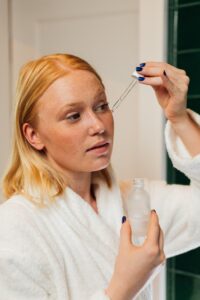The Benefits of Using Kojic Acid

Dark spots are a common skin concern that can be caused by a variety of factors, including sun damage, aging, hormonal changes, and acne. While there are many products on the market that claim to fade dark spots, one ingredient that has been gaining popularity in recent years is kojic acid. Kojic acid is a natural ingredient that has been used for centuries in traditional Japanese cuisine and medicine. In skincare, kojic acid is prized for its ability to reduce the appearance of dark spots and hyperpigmentation. In this article, we’ll take a closer look at kojic acid and how it can help you achieve a brighter, more even complexion.
What is Kojic Acid?
Kojic acid is a natural compound that is derived from several different types of fungi. It is commonly used in food production to prevent browning and discoloration, and has been used in skincare for its skin-brightening properties. Kojic acid works by inhibiting the production of melanin, the pigment that gives skin its color. By blocking melanin production, kojic acid can help to reduce the appearance of dark spots and hyperpigmentation.
How Does Kojic Acid Work?
Kojic acid works by inhibiting the activity of tyrosinase, an enzyme that is involved in the production of melanin. Melanin is produced by cells called melanocytes, which are located in the basal layer of the epidermis. When the skin is exposed to UV radiation or other forms of environmental stress, melanocytes can become overactive and produce excess melanin. This can lead to the development of dark spots and hyperpigmentation.
By inhibiting tyrosinase activity, kojic acid can help to reduce the amount of melanin produced by melanocytes. This can lead to a more even skin tone and a reduction in the appearance of dark spots and hyperpigmentation.
Is Kojic Acid Safe?
While kojic acid is generally considered safe for use in skincare, there are some potential risks to be aware of. One of the main concerns with kojic acid is that it can cause skin irritation and sensitivity, particularly in those with sensitive or allergy-prone skin. Additionally, kojic acid can make the skin more sensitive to UV radiation, which can increase the risk of sun damage and skin cancer. For this reason, it’s important to use sunscreen and other forms of sun protection when using kojic acid products.
How to Use Kojic Acid
If you’re interested in using kojic acid to reduce the appearance of dark spots and hyperpigmentation, there are a few different options to choose from. One of the most common ways to use kojic acid is in the form of a serum or cream. These products can be applied directly to the skin and are typically used once or twice a day, depending on the instructions provided by the manufacturer.
Another option for using kojic acid is in the form of a facial mask. Kojic acid masks are typically applied to the skin for a period of 10-20 minutes and then rinsed off with warm water. This can help to brighten the skin and reduce the appearance of dark spots and hyperpigmentation.
It’s important to note that kojic acid can be quite strong, so it’s important to start with a low concentration and gradually increase the strength if necessary. Additionally, it’s important to follow the instructions provided by the manufacturer and avoid overusing kojic acid products, as this can lead to skin irritation and sensitivity.

Other Tips for Reducing Dark Spots
While kojic acid can be an effective way to reduce the appearance of dark spots and hyperpigmentation, there are other steps you can take to promote a more even skin tone.
Here are some additional tips for reducing dark spots and promoting a more even skin tone:
- Wear Sunscreen: UV radiation is one of the primary causes of dark spots and hyperpigmentation, so it’s important to protect your skin from the sun. Make sure to wear sunscreen with an SPF of at least 30 every day, even on cloudy days.
- Use Vitamin C: Vitamin C is a potent antioxidant that can help to brighten the skin and reduce the appearance of dark spots. Look for skincare products that contain vitamin C, or consider using a vitamin C serum.
- Exfoliate Regularly: Exfoliation can help to remove dead skin cells and promote cell turnover, which can help to reduce the appearance of dark spots. However, be careful not to over-exfoliate, as this can cause skin irritation and sensitivity.
- Use Retinoids: Retinoids are a type of vitamin A derivative that can help to improve skin texture and tone. They can also help to reduce the appearance of dark spots and hyperpigmentation. However, retinoids can be quite strong, so it’s important to start with a low concentration and gradually increase the strength if necessary.
- Maintain a Healthy Lifestyle: A healthy diet and lifestyle can also help to promote a more even skin tone. Make sure to eat a balanced diet rich in fruits, vegetables, and other nutrient-dense foods. Exercise regularly and get enough sleep to help your skin look its best.
In conclusion, kojic acid is a natural ingredient that can be an effective way to reduce the appearance of dark spots and hyperpigmentation. However, it’s important to use kojic acid products responsibly and in accordance with the manufacturer’s instructions. Additionally, there are other steps you can take to promote a more even skin tone, such as wearing sunscreen, using vitamin C, exfoliating regularly, using retinoids, and maintaining a healthy lifestyle. By combining these strategies, you can achieve a brighter, more even complexion and say goodbye to dark spots for good.



